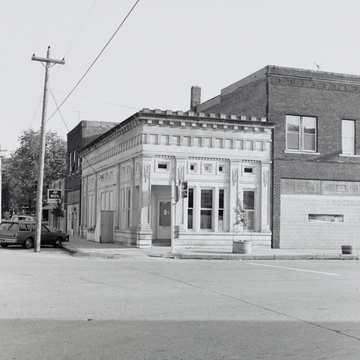The Beaux-Arts Classical concept of design is effectively realized in this small corner building. This bank is one of the most inventive interpretations of the Beaux-Arts to be found in Iowa. As with almost all small-town banks, this one is essentially a rectangular box that makes its statement by its fenestration and through its varied parapet. The design has the feeling of the delicate Renaissance forms one associates with northern Italy in the early fifteenth century. But when one examines how pilasters, the building's base, its entablature, cornice, and parapet have been handled, it is apparent that the building has little to do with a revival of early Renaissance architecture. The entablature, for example, with its pattern of tri-glyphs, seems to take us back to Greece, not Florence, and there is a suggestion of crenellation above the parapet,
You are here
Bank Building
c. 1917, attrib. The Lytle Company. 246 Main St.
If SAH Archipedia has been useful to you, please consider supporting it.
SAH Archipedia tells the story of the United States through its buildings, landscapes, and cities. This freely available resource empowers the public with authoritative knowledge that deepens their understanding and appreciation of the built environment. But the Society of Architectural Historians, which created SAH Archipedia with University of Virginia Press, needs your support to maintain the high-caliber research, writing, photography, cartography, editing, design, and programming that make SAH Archipedia a trusted online resource available to all who value the history of place, heritage tourism, and learning.










